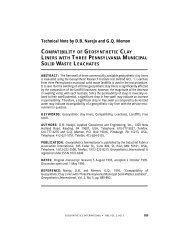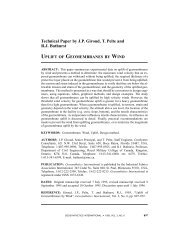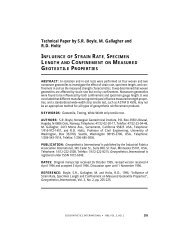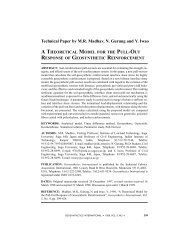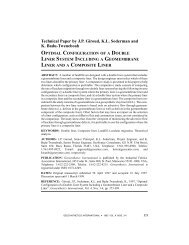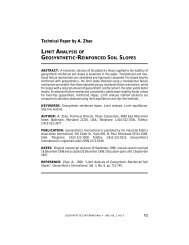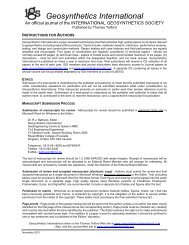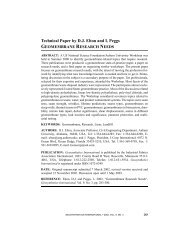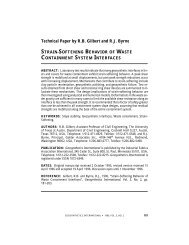discharge capacity of prefabricated vertical drains confined in clay
discharge capacity of prefabricated vertical drains confined in clay
discharge capacity of prefabricated vertical drains confined in clay
Create successful ePaper yourself
Turn your PDF publications into a flip-book with our unique Google optimized e-Paper software.
MIURA AND CHAI D Discharge Capacity <strong>of</strong> Prefabricated Vertical Dra<strong>in</strong>s Conf<strong>in</strong>ed <strong>in</strong> Clay<br />
3. Place the remolded <strong>clay</strong> (at a water content approximately equal to the liquid limit)<br />
<strong>in</strong>to the mold layer-by-layer until the desired height is atta<strong>in</strong>ed.<br />
4. Install the top pedestal and connect the PVD specimen to the outlet water flow system.<br />
Fix the rubber membrane to the top pedestal.<br />
5. Apply a suction <strong>of</strong> approximately 10 kPa to the specimen and remove the mold.<br />
6. Apply the conf<strong>in</strong><strong>in</strong>g pressure and gradually release the suction.<br />
7. Set the desired hydraulic gradient.<br />
8. Allow the <strong>clay</strong> to consolidate under a given conf<strong>in</strong><strong>in</strong>g pressure. After the <strong>clay</strong> consolidates,<br />
measure the <strong>discharge</strong> <strong>capacity</strong>.<br />
Four types <strong>of</strong> PVDs commonly used <strong>in</strong> Japan were tested. The four PVDs have different<br />
core structures (Figure 2) and filters (Table 1). Both rubber membrane-<strong>conf<strong>in</strong>ed</strong><br />
(approximately 0.9 mm thick) and <strong>clay</strong>-<strong>conf<strong>in</strong>ed</strong> tests were conducted. To simulate<br />
long-term field behavior, the <strong>clay</strong>-<strong>conf<strong>in</strong>ed</strong> tests were approximately three months long<br />
(except for one test). A micro pump was used to recirculate the water (tap water, not<br />
de-aired) dur<strong>in</strong>g the tests. The tests were conducted <strong>in</strong> an air-conditioned room with the<br />
temperature typically with<strong>in</strong> the range <strong>of</strong> 18 to 26_C. The pump motor was not placed<br />
<strong>in</strong> the water to ensure that it would have no effect on the water temperature. Most tests<br />
were conducted at a conf<strong>in</strong><strong>in</strong>g pressure, σ, <strong>of</strong> 49 kPa. Assum<strong>in</strong>g an earth pressure coefficient<br />
<strong>of</strong> 0.5, 49 kPa represents the horizontal earth pressure under an embankment<br />
approximately 5 m high, or the <strong>in</strong>itial horizontal earth pressure at a depth <strong>of</strong> approximately<br />
10 m <strong>in</strong> the ground. Remolded Ariake <strong>clay</strong>, which consisted <strong>of</strong> 57.0% <strong>clay</strong>,<br />
41.7% silt, and 1.3% sand particles, was used (liquid limit <strong>of</strong> 105.0% and a plastic limit<br />
<strong>of</strong> 42.8%).<br />
For the test apparatus used (Figure 1), an amount <strong>of</strong> head loss is associated with the<br />
hose connect<strong>in</strong>g the <strong>in</strong>let and outlet water tanks, which should be considered when <strong>in</strong>terpret<strong>in</strong>g<br />
the test results. To calibrate the head loss, a test without a PVD specimen and<br />
soil column was conducted. In this case, the water flowed from the <strong>in</strong>let water tank to<br />
the outlet water tank through the hoses and cyl<strong>in</strong>drical chamber only. The head difference,<br />
∆H, between the <strong>in</strong>let and outlet water tanks was varied, and the correspond<strong>in</strong>g<br />
amount <strong>of</strong> water flow, Q, was measured. The Q versus ∆h relationship for this test device<br />
is plotted <strong>in</strong> Figure 3. This curve was used to correct the test results accord<strong>in</strong>g to<br />
the follow<strong>in</strong>g procedure:<br />
Table 1.<br />
Physical properties <strong>of</strong> the <strong>prefabricated</strong> <strong>vertical</strong> dra<strong>in</strong> (PVD) filters.<br />
Property<br />
PVD filter<br />
PVD A PVD B PVD C PVD D<br />
Mass/unit area (g/m 2 ) 50 37 50 154<br />
Thickness (mm) 0.21 0.12 0.21 0.44<br />
Polymer Polyester Polyolef<strong>in</strong> Polyester Polypropylene<br />
Manufactur<strong>in</strong>g<br />
process<br />
Cont<strong>in</strong>uous filament<br />
(heat-bonded)<br />
Short fibre<br />
(heat-bonded)<br />
Cont<strong>in</strong>uous filament<br />
(heat-bonded)<br />
Short fibre<br />
(heat-bonded)<br />
122 GEOSYNTHETICS INTERNATIONAL S 2000, VOL. 7, NO. 2



